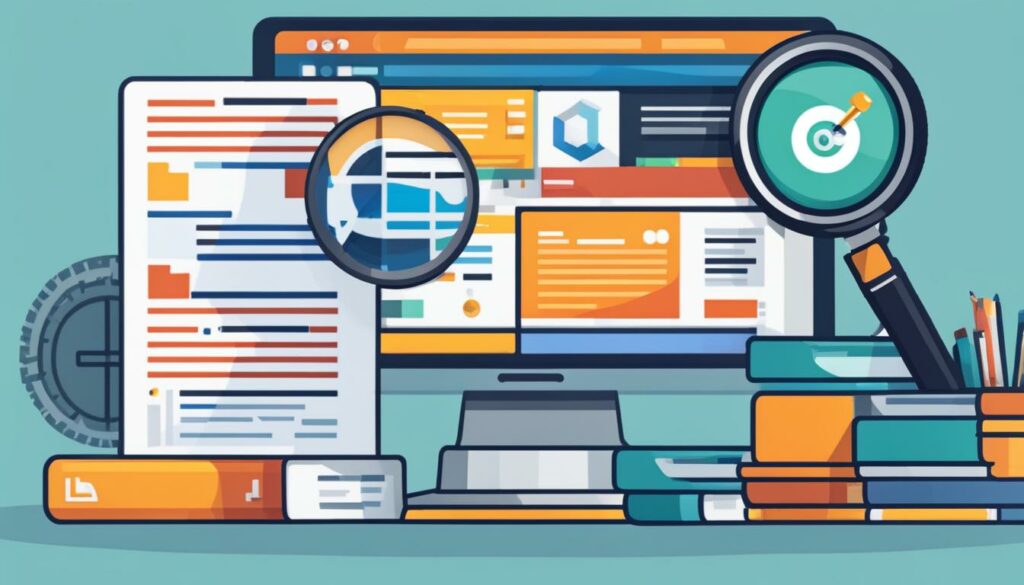Welcome to our Beginners’ Guide to scaling WordPress efficiently! As an online business owner, you know how important it is to optimize your WordPress website for search engines. By improving its SEO performance, you can attract more visitors and increase your online visibility. In this guide, we will provide you with valuable WordPress SEO tips and strategies to help your website thrive.
When it comes to optimizing WordPress for search engines, there are various factors to consider. From improving loading speed to implementing website caching, we have got you covered. In this guide, we will delve into the impact of high traffic on page speed and discuss strategies for scaling WordPress effectively.
By implementing these WordPress SEO strategies, you can improve your website’s performance under heavy traffic, enhance user experience, and boost your search engine rankings. Let’s dive in and discover how to optimize your WordPress site for maximum scalability!
Key Takeaways:
- Optimizing your WordPress website is crucial for improving its performance and search engine rankings.
- Understanding the impact of high traffic on page speed will help you identify areas for improvement.
- Implementing scalable strategies such as website caching and database optimization is essential for handling heavy web traffic.
- Improving loading speed and fixing broken links are crucial aspects of optimizing WordPress for search engines.
- Optimizing image usage can significantly reduce page weight and improve overall site performance.
Understanding the Impact of High Traffic on Page Speed
When users access your website, their browsers request data from the host server. During heavy traffic, the server may struggle to deliver the website data to more users, especially for complex WordPress sites with large amounts of data such as high-resolution images and videos. This can have a significant impact on the page speed, affecting the overall user experience and even your site’s search engine rankings.
To understand why high traffic negatively impacts page speed, let’s look at a few key factors:
- WordPress performance: Complex WordPress sites with multiple plugins, custom themes, and database queries require more processing power to generate and deliver content. As the number of simultaneous requests from visitors increases, the server’s processing power is divided among multiple users, resulting in slower response times.
- Website speed: When your website receives a high volume of traffic, it puts a strain on the server’s resources. The server needs to handle multiple requests simultaneously, which can lead to longer loading times and delays in delivering content to users.
- Processing power: Heavy traffic requires more processing power from the server to handle the increased workload. If your server is not equipped with sufficient processing power, it may struggle to keep up with the demands, causing delays in delivering content and slower page speeds.
- Complex WordPress sites: Websites with intricate designs, numerous plugins, and large media files can significantly impact page speed during high traffic periods. Each element on the page requires additional server resources to load, resulting in slower loading times when multiple users are accessing the site simultaneously.
To mitigate the impact of high traffic on page speed and ensure optimal performance for your complex WordPress site, consider implementing the following strategies:
- Optimize your WordPress performance by streamlining plugins, optimizing your theme code, and utilizing caching techniques.
- Implement a content delivery network (CDN) to distribute the server load and deliver content more efficiently to users worldwide.
- Optimize your images by compressing them without compromising quality. Large image files can significantly slow down page loading times.
- Utilize a caching plugin to cache static content and reduce the load on your server during peak traffic.
- Consider upgrading your server infrastructure or hosting plan to ensure adequate processing power and resources to handle high traffic periods.
By understanding the impact of high traffic on page speed and implementing these strategies, you can improve the user experience, retain visitor engagement, and maintain optimal performance for your complex WordPress site even during peak traffic periods.
Strategies for Scaling WordPress
WordPress websites are not designed to handle high web traffic by default. However, with proper configuration and implementation of key strategies, you can efficiently scale your online business and ensure optimal performance even during periods of heavy visitor loads.
Optimizing Database Loading
Database loading plays a crucial role in the performance of your WordPress site. By optimizing database queries, minimizing unnecessary data retrieval, and fine-tuning the configuration, you can significantly enhance the scalability of your website. Streamlining your database loading process can help reduce the server load and improve response times, enabling your WordPress site to handle a larger number of visitors effectively.
Managing a Large Number of Visitors
Managing a large influx of visitors is a common challenge for websites experiencing scalability issues. To handle a large number of visitors effectively, consider implementing load balancing techniques and utilizing caching mechanisms. Load balancing distributes inbound traffic across multiple servers, preventing overload and ensuring seamless user experience. Caching, on the other hand, stores static versions of your web pages, reducing the strain on your server and optimizing response times.
Implementing Website Caching
Implementing website caching is a crucial strategy for improving WordPress scalability. By caching your website’s content, such as HTML, CSS, and JavaScript files, you can reduce the processing load on the server and deliver content to visitors more efficiently. Utilize caching plugins like W3 Total Cache or WP Super Cache to simplify the caching setup process and improve the overall performance of your site.
| Strategy | Description |
|---|---|
| Optimizing Database Loading | Streamline database queries to reduce server load and enhance response times. |
| Managing a Large Number of Visitors | Implement load balancing and use caching mechanisms to handle high traffic volumes effectively. |
| Implementing Website Caching | Cache website content to reduce server load and deliver content efficiently. |
| Optimizing Media Resources | Efficiently optimize images and other media resources to improve loading speed and decrease server load. |
| Creating a High-End Coding Architecture | Develop a robust and scalable coding architecture to ensure optimal performance even during high traffic periods. |
Optimizing Media Resources
Media resources, such as images and videos, can significantly impact website performance. Optimize your media files by compressing them without sacrificing quality, resizing images to appropriate dimensions, and implementing lazy loading techniques. These optimizations will reduce the server load and improve the overall loading speed of your site, ensuring a smooth user experience even during peak traffic times.
Creating a High-End Coding Architecture
The coding architecture of your WordPress site plays a crucial role in its scalability. Develop a high-end coding architecture that follows best practices, such as properly organizing files and directories, utilizing efficient coding techniques, and implementing proper error handling. A well-structured coding architecture can help your site handle a large number of visitors without compromising performance.
By implementing these strategies, you can enhance the scalability of your WordPress website, provide a seamless user experience even during heavy traffic periods, and ensure optimal performance for your online business.

Improving Loading Speed
When it comes to website optimization, loading speed plays a crucial role. Slow loading times not only frustrate visitors but also impact your search engine rankings. In fact, studies have shown that even a one-second delay in page load time can result in a 7% reduction in conversions.
Measuring your website’s loading time is the first step towards improving its performance. One tool that can help you with this is Google PageSpeed Insight. It provides valuable insights into your site’s loading speed and offers recommendations for improvement.

Website Speed Improvement Strategies:
- Optimize image sizes: Large image files can significantly slow down your website. Make sure to optimize your images by compressing them without sacrificing quality. This will help reduce their file sizes and improve loading speed.
- Use a content delivery network (CDN): A CDN is a network of servers located in different geographic locations. By delivering your website’s content from the server closest to the user, CDNs help minimize latency and improve loading speed.
- Minify your CSS and JavaScript: Minification is the process of removing unnecessary characters from your CSS and JavaScript files, such as white spaces and comments. This reduces file sizes and improves loading time.
- Implement caching: Caching involves temporarily storing static files, such as HTML pages and images, on the user’s device or in a proxy server. This helps reduce server load and improves loading speed for returning visitors.
- Optimize your code: Clean and optimized code can improve your website’s performance. Make sure to eliminate any redundant or inefficient code that may slow down your website.
Remember, a fast-loading website not only improves user experience but also contributes to higher search engine rankings. By implementing these website speed improvement strategies, you can ensure that your WordPress site loads quickly and efficiently.
Implementing Website Caching
When it comes to improving website performance, website caching is an essential technique. By enabling caching, you can store site data for future use, reducing the load on the server and improving response times. This section will discuss different types of website caching and recommend popular WordPress caching plugins that can help skyrocket your website’s speed and user experience.
Understanding Website Caching
Website caching involves temporarily storing data so that it can be quickly accessed when requested again. This saves valuable server resources and ensures faster loading times for your visitors. Two common types of caching are server-side caching and browser caching.
Server-side caching involves caching website data on the server itself, allowing for faster retrieval and reducing the need to recreate the same content repeatedly. On the other hand, browser caching involves storing certain static website elements, such as images and JavaScript files, on the user’s device, reducing the need to fetch them with each visit.
Popular WordPress Caching Plugins
Several WordPress caching plugins are available to simplify the implementation of caching on your website. Here are three top choices:
- LiteSpeed Cache: A powerful caching plugin designed specifically for LiteSpeed server users. It offers a wide range of features and optimizations to improve your website’s performance.
- WP Super Cache: This plugin generates static HTML files of your dynamic WordPress site to serve to your visitors. It is easy to set up and provides an excellent solution for websites with high traffic.
- W3 Total Cache: W3 Total Cache is a comprehensive caching plugin that offers advanced features such as content delivery network integration and database optimization. It is highly customizable and supports various caching methods.
These plugins simplify the caching process and provide extensive configuration options to ensure optimal performance for your WordPress website.
Handling Caching Errors and Clearing WordPress Site Cache
While caching greatly improves website performance, it can sometimes lead to issues if not properly managed. Caching errors can occur when outdated pages or content are displayed to users. To address these issues, it’s essential to understand how to handle caching errors and clear your WordPress site cache when necessary.
When caching errors arise, clearing your website’s cache can help resolve the issue. Most caching plugins offer a simple way to clear the cache, either automatically or manually. Clearing the cache ensures that your website displays the latest content and prevents any potential conflicts caused by outdated cached data.
Remember to regularly clear your WordPress site cache to ensure that your visitors always receive the most up-to-date and accurate information.

Implementing website caching is a crucial step in optimizing your WordPress site’s performance. By enabling caching and using popular caching plugins like LiteSpeed Cache, WP Super Cache, and W3 Total Cache, you can significantly improve your website’s speed and user experience. Just remember to handle caching errors promptly and clear your WordPress site cache regularly to ensure optimal performance.
Enhancing Website Security
Ensuring the security of your WordPress site is crucial, especially when it comes to handling high web traffic. Implementing effective security measures can protect your website from unauthorized access, data breaches, and other potential threats. By following these tips, you can enhance your website security and minimize the risk of security vulnerabilities.
Regularly Updating WordPress
Keeping your WordPress installation up to date is essential for maintaining a secure website. WordPress releases regular updates that address security issues and vulnerabilities. By regularly updating your WordPress version, themes, and plugins, you can ensure that you have the latest security patches and bug fixes to protect your site.
Using Secure Admin Login Credentials
Creating strong admin login credentials is a vital step in securing your WordPress site. Use a unique username and a strong, complex password that combines uppercase and lowercase letters, numbers, and special characters. Avoid using common phrases or easily guessable passwords to prevent unauthorized access to your admin dashboard.
Installing Trusted Themes and Plugins
Selecting trusted themes and plugins from reputable sources is crucial for maintaining website security. Choose themes and plugins that have a good track record of regular updates and support from the developers. Avoid downloading themes or plugins from unknown sources, as they may contain malicious code that can compromise your website’s security.
Utilizing SSL Certificates
Implementing SSL (Secure Socket Layer) certificates on your website is essential for securing sensitive data, such as login credentials, credit card information, and personal details. SSL certificates encrypt data transmitted between your website and users’ browsers, ensuring that it cannot be intercepted by hackers. This not only enhances security but also improves your site’s trustworthiness.
Removing Unused Themes and Plugins
Unused themes and plugins can pose a security risk if they are not regularly updated. Hackers can exploit vulnerabilities in outdated or abandoned themes and plugins to gain unauthorized access to your website. It’s essential to remove any unused themes and plugins from your WordPress installation to minimize potential security breaches.
Security Plugins
Installing security plugins can provide an additional layer of protection to your WordPress site. These plugins offer features such as malware scanning, firewall protection, login security, and activity monitoring. One popular security plugin is Wordfence, which provides comprehensive security solutions to safeguard your WordPress site against various threats.
By implementing these security measures, you can enhance the overall security of your WordPress site and protect it from potential security vulnerabilities. Strengthening your website security is crucial for maintaining a secure online presence and ensuring the trust of your visitors.
| Security Measure | Description |
|---|---|
| Regularly Updating WordPress | Ensuring your WordPress installation, themes, and plugins are up to date with the latest security patches and bug fixes. |
| Using Secure Admin Login Credentials | Creating strong and unique admin login credentials to protect against unauthorized access to your admin dashboard. |
| Installing Trusted Themes and Plugins | Choosing themes and plugins from reputable sources that have a good track record of regular updates and support. |
| Utilizing SSL Certificates | Implementing SSL certificates to encrypt data transmitted between your website and users’ browsers. |
| Removing Unused Themes and Plugins | Removing any unused themes and plugins from your WordPress installation to minimize potential security breaches. |
| Security Plugins | Installing security plugins such as Wordfence to add an extra layer of protection to your WordPress site. |
Optimizing Image Usage
Images play a crucial role in the overall performance of your WordPress website. They not only add visual appeal but also contribute significantly to page weight and loading speed, particularly during traffic spikes. To ensure that your site remains fast and efficient, it’s essential to optimize your image usage through various techniques.
Image Optimization
Image optimization involves reducing the file size of your images without compromising their quality. By doing so, you can significantly decrease the load time of your web pages. There are several ways to optimize your images:
- Image Compression: Use specialized tools or plugins to compress your images. This reduces the file size while maintaining satisfactory image quality.
- Image Resizing: Resize your images to fit the dimensions required by your website. This prevents unnecessary large images from slowing down page loading times.
Caching Images
Caching images involves storing image files on the user’s device or the server, allowing them to be quickly retrieved instead of being downloaded each time a page is accessed. This technique reduces server load and improves loading speed. Implement caching plugins like W3 Total Cache or WP Super Cache to enable image caching on your WordPress site.
| Image Optimization Techniques | Benefits |
|---|---|
| Image Compression | Reduces file size without compromising quality |
| Image Resizing | Prevents large images from slowing down page loading times |
| Caching Images | Improves loading speed by storing images for quick retrieval |
Clearing WordPress Media Library
Over time, your WordPress media library may become cluttered with unused images, which can increase the overall page weight. It’s important to regularly review and remove any unnecessary images. This not only clears up space but also improves the efficiency of your website.
Reducing the page weight by optimizing image usage helps enhance the overall site performance. By implementing image compression, resizing, caching, and clearing up your WordPress media library, you can significantly improve your website’s loading speed and ensure a smooth user experience even during traffic spikes.
Fixing Broken Links
Broken links can have a negative impact on the user experience of your website, causing frustration and potentially driving visitors away. Additionally, search engines view broken links as URL errors, which can harm your website’s ranking. It is crucial to regularly check for broken links and fix them promptly to ensure a seamless user experience and maintain a healthy online presence.
To identify and repair broken links, you can rely on WordPress SEO tools and plugins like Broken Link Checker. This plugin scans your website for broken links and provides a detailed report of the URLs that need attention. With this information, you can easily identify and fix the broken links on your WordPress site.
“A seamless user experience during traffic spikes is crucial for maximizing the benefits of high web traffic.”
Steps to Fix Broken Links using Broken Link Checker:
- Install and activate the Broken Link Checker plugin on your WordPress website.
- Access the plugin settings and configure the desired scan intervals and notification preferences.
- Wait for the plugin to complete its initial scan of your website. The time taken for the scan will depend on the size of your website.
- Review the report generated by the Broken Link Checker plugin.
- Click on each broken link to view the specific URL and where it is located on your website.
- Take the necessary steps to fix each broken link. This may involve updating the URL, removing the link, or redirecting it to a working page.
- Regularly revisit the Broken Link Checker plugin to ensure that new links do not become broken and fix them promptly if they do.
By fixing broken links, you not only enhance the user experience of your website but also maintain a healthy SEO profile. A seamless user experience during traffic spikes is crucial for maximizing the benefits of high web traffic and ensuring that visitors can navigate your site effortlessly.
Ensure a seamless user experience and optimize your website for search engines by regularly checking for broken links and fixing them using tools like Broken Link Checker. Your users and search engines will appreciate the effort, resulting in improved user satisfaction and a better ranking in search engine results.
Conclusion
Scaling your WordPress website efficiently is crucial for handling high web traffic and maintaining optimal performance. By implementing the strategies discussed in this article, including optimizing loading speed, implementing website caching, enhancing security, optimizing image usage, and fixing broken links, you can ensure that your WordPress site is scalable and capable of handling any amount of traffic.
Improving your site’s loading speed will enhance user experience and reduce bounce rates. Implementing website caching techniques, such as utilizing caching plugins like LiteSpeed Cache, WP Super Cache, and W3 Total Cache, will help reduce the load on the server and improve response times.
Enhancing website security is equally important for scaling WordPress. Regularly updating WordPress, using secure admin login credentials, installing trusted themes and plugins, and utilizing SSL certificates will safeguard your site during traffic spikes. Additionally, optimizing image usage by compressing, resizing, caching, and clearing up the WordPress media library will reduce page weight and improve overall site performance.
To maximize the benefits of high web traffic, it is crucial to identify and fix broken links using WordPress SEO tools and plugins like Broken Link Checker. Ensure a seamless user experience and elevate your WordPress site’s visibility by following these expert WordPress SEO tips. Implementing these strategies will make your WordPress site scalable, allowing it to handle any amount of traffic and climb the search engine ranks.
FAQ
Q: Can scaling my WordPress website improve SEO?
A: Yes, scaling your WordPress website can improve your SEO. Faster loading times, optimized images, and a seamless user experience during high traffic periods can positively impact your website’s ranking on search engines.
Q: How do I measure my website’s loading time?
A: You can measure your website’s loading time using tools like Google PageSpeed Insight. These tools analyze your site’s performance and provide recommendations for improving loading speed.
Q: What is website caching, and how does it improve performance?
A: Website caching is a technique for storing site data for future use. By enabling caching, you can reduce the load on the server and improve response times, ultimately enhancing your website’s performance.
Q: What are some popular caching plugins for WordPress?
A: Some popular caching plugins for WordPress include LiteSpeed Cache, WP Super Cache, and W3 Total Cache. These plugins help improve performance by efficiently caching and delivering website data.
Q: How can I enhance the security of my WordPress website?
A: To enhance the security of your WordPress website, you should regularly update WordPress, use secure admin login credentials, install trusted themes and plugins, utilize SSL certificates, and remove unused themes and plugins. Additionally, using security plugins like Wordfence can provide an extra layer of protection.
Q: How can I optimize the usage of images on my WordPress site?
A: To optimize image usage on your WordPress site, you can compress images, resize them appropriately, enable image caching, and regularly clean up your WordPress media library. These techniques help reduce the page weight and improve overall site performance.
Q: How do I fix broken links on my WordPress site?
A: You can fix broken links on your WordPress site by using tools and plugins like Broken Link Checker. These tools scan your website for broken links and provide an easy way to identify and repair them, ensuring a seamless user experience.












